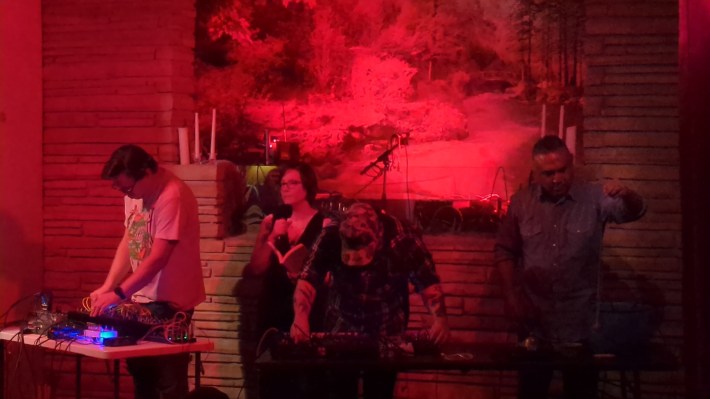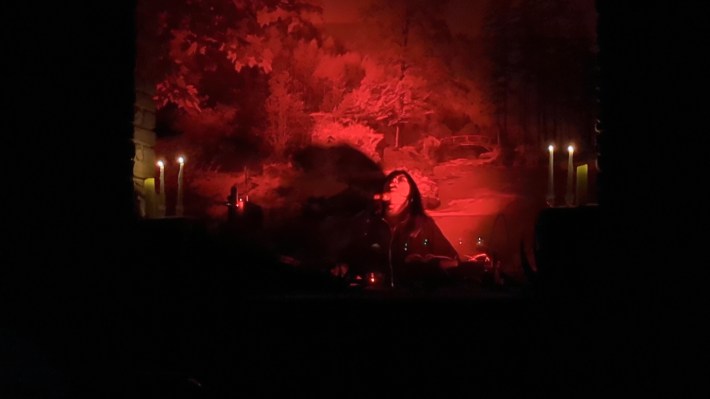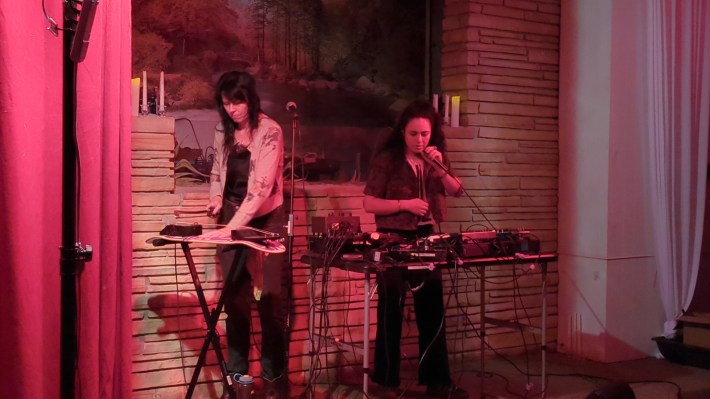Charmaine Lee / Godseye / White Boy Scream + Sarah Ruth Alexander
Drifters Theater
October 13, 2025
“Melancholia is, I believe, a musical problem: a dissonance, a change in rhythm.” —Alejandra Pizarnik
When my editor reached out to me about a last-minute opportunity to cover a noise show at Drifters Theater in just a few hours, I was already grabbing my earplugs and notepad before I even read the whole email. Going to Drifters, a music and event venue that Dylan Aycock opened earlier this year, has been on my to-do list for a while and this was the perfect opportunity to check it out. To sweeten the deal, I knew the lineup was going to be something extra special, with local group Godseye making a return after 15 years, Tulsa Artist Fellow White Boy Scream teaming up with Texas musician Sarah Ruth Alexander, and Charmaine Lee coming to town as part of her dizzying “65 shows in 50 states” tour. So, like so many in the Tulsa music scene before me, I finished up my shift at the coffee house as fast as I could, got in my economy hatchback, and made the pilgrimage to Owen Park.
Parking my car on a steep hill (e-brake from 2006, don’t fail me now), I walked up to the softly lit and inviting former Owen Park Baptist Church. The scene inside was already busy, with gear being moved in, local beers being cracked, and folks finding their seats in rows of pews. The slanted floor gently pushes you towards the two-section stage, one close to ground, another raised against a beautiful painted background of a forest. Red and black curtains, candles, and a church atmosphere absent of any Christian aesthetic invoke a ‘70s psychedelic cult classic film vibe, something with a killer soundtrack and obnoxious fans. The atmosphere made me feel underdressed in my usual barista fatigues. (I knew that was the day to break out my maroon velvet cape: rats.) A crowd of about 25-30 gathered to see three noise-genre-related acts that each brought a completely different sound and atmosphere to this tiny church.



photos by Henry Roanhorse Gray
Godseye took the stage first, their gear lining its entire length. This group—whose members include an Osage Nation archaeologist (Eden Hemming), a former Delaware Tribal Council Member (Nathan Young), and the founder of Foxy Digitalis and co-founder of The Bird House micro-gallery (Brad Rose)—created an incredible, earthy, angry, yet comforting sound alongside multidisciplinary artist Warren Realrider (Pawnee/Crow), who joined them for this performance marking their return to the stage after a 15-year hiatus.
As Hemming read poems by Alejandra Pizarnik and Elizabeth Bishop with a methodical clarity, Young, Rose, and Realrider began to play slow, quiet accompaniments that soon descended into sonic strangeness. Modular synths, microphones, a bowl clipped to microphones—all ravenously tore through the lines of poetry, invoking a slow-moving glacier tearing through ice age plains and old growth forests. Organic rocks and metal bells clinked and chipped against a bowl used by Realrider, punctuating the works of Pizarnik and Bishop. Mirroring the pulsing modular synth, vocal modulators ripped, echoed, and emboldened Hemming’s reading of the poems. Wires twisted and curled like tree roots out of and around the synth boxes, anchoring the poetic imagery to the stage floor they spilled down to.
Themes of death and decay wandered through the set, with tales of strange, foreign lands, labyrinths, exile, connection, and empathy disappearing behind the jagged and abrasive sound developing around it. The noise ended slowly as the last poem reached its zenith, and Hemming’s voice calmly concluded the last stanza as the musicians faded their instruments into a gentle rolling wave that receded back to whence it came.

The Australian-born and New York-based Charmaine Lee performed next, taking her spot in the elevated second stage, originally the church’s baptismal area. Lee noted that she had never played in a venue like this, despite being on the 40th show of her 65-show tour across all 50 states. She asked if a small Baptist church like this was a common sight for Tulsa, and the crowd reacted with a gleeful affirmative. Lee continued to banter with the crowd, mentioning an earlier technical issue involving a very small local: "We had to airlift a scorpion out of the baptism vestibule, which I feel is the most Oklahoma experience ever." With the small beastie safely removed from what was probably the best seat in the house, the show could go on.
Lee’s works are based around creating “singular musical languages,” then sharing those languages through live performance—an approach that didn’t quite click for me until her set began. The set was incredibly improvisational, featuring four mics each going into a different type of modulator, from vocal synthesizers and loopers to an old modified handheld cassette player. This set-up, combined with Lee’s lightning-fast vocal scuttering, clicking, ticking, and screaming, created a language that seemed far more insectile than human. With sparse candles and red stage lights as the room’s only illumination, and with the sound pinging around the space, taking full advantage of Drifter’s speakers and acoustics, I felt like I was trapped in a room with something that wasn’t quite human, beast, or bug.

Whatever Lee was conjuring spoke to me. I noted she was using a radio, a personally-nostalgic black plastic 1990s model, tuning its dials across AM bands. I asked her after the show if she was using a prerecorded tape to sample and mix for consistency, and she said no—she tunes it to nearby stations, thus making each show unique and flavored by local airwaves. When I asked about the handheld cassette tape player, she laughed and said, “Everyone thinks it's a vape!”
To close the show, experimental opera singer Micaela Tobin (performing under her project White Boy Scream) took the stage joined by Sarah Ruth Alexander from Denton, Texas. Both are accomplished multi-instrumentalists, and Tobin spoke of how excited she was to work with Alexander on this set. A slew of effects pedals stood before them alongside a handmade strung skateboard instrument, which sat like Chekhov’s gun on the stage, with everyone glancing at the bespoke board, anticipating its use in the set.
The two performers used highly processed vocals that sounded at times more like trumpets from on high, or perhaps a deadly harpy enticing its prey (Act 1 in Baldur’s Gate 3, anyone?). Cicada-like drones shimmered in the background as the heavily modulated vocals rang through the pews, Tobin’s opera prowess on full display alongside Alexander’s own incredible extended vocal movements.

After a while, Alexander slid a bow along that strung skateboard, its trucks holding thin strings taut down its length. The tone of the “stringboard” was creaking and moaning, grinding through achingly long notes that added organic richness to the electronically altered vocals. As the vocals melted and pitched between hum, hymn, and harbinger, the board turned into a percussion instrument, as Alexander added an archaic rhythm to the pair’s metallic and granular vocals. Loops of feedback crashed into waves of distortion, seemingly reaching gale wind speeds at times, until it all came to a calm rest. Tobin and Alexander exchanged a warm glance of accomplishment for a beat once the sound had ended, embracing as the crowd applauded.
After taking some time after the show to examine the skateboard up close, get some Charmaine Lee stickers, and enjoy company on the beautiful patio that looked out on the Tulsa skyline, I made my way home. Often noise as a genre can be made into a joke, a genre of rich kids tossing microphones into blenders, all of it sort of blending (pun intended) together sonically. To be fair, it can be exactly that, and there is still fantastic art and community to be found in it. I've been to some amazing “will-it-blend” type noise shows and had a blast.
Still, there is so much more to be found within this genre, and it can be heard right here in Tulsa. With locally-based talent like Godseye and White Boy Scream, plus Drifters bringing in international acts like Lee, the noise scene is flourishing with an incredible range of sound, scope, and meaning. While acts like these may represent a more “high-brow” or even intellectual section of the noise genre, you never get too far from some very fancy gear being used with caveman levels of delight and care, something that brings a smile to my face every time. Drifters, Foxy Digitalis, and the Tulsa Artist Fellowship put together one incredible set that’s going to be ringing in my ears for a while.






